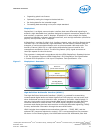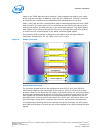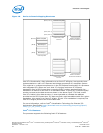
• More reliable: Due to the hardware support, VMMs can now be smaller, less
complex, and more efficient. This improves reliability and availability and reduces
the potential for software conflicts.
• More secure: The use of hardware transitions in the VMM strengthens the
isolation of VMs and further prevents corruption of one VM from affecting others
on the same system.
Intel
®
VT-x Features
The processor supports the following Intel VT-x features:
• Extended Page Table (EPT) Accessed and Dirty Bits
— EPT A/D bits enabled VMMs to efficiently implement memory management and
page classification algorithms to optimize VM memory operations, such as de-
fragmentation, paging, live migration, and check-pointing. Without hardware
support for EPT A/D bits, VMMs may need to emulate A/D bits by marking EPT
paging-structures as not-present or read-only, and incur the overhead of EPT
page-fault VM exits and associated software processing.
• Extended Page Table Pointer (EPTP) switching
— EPTP switching is a specific VM function. EPTP switching allows guest software
(in VMX non-root operation, supported by EPT) to request a different EPT
paging-structure hierarchy. This is a feature by which software in VMX non-
root operation can request a change of EPTP without a VM exit. Software can
choose among a set of potential EPTP values determined in advance by
software in VMX root operation.
• Pause loop exiting
— Support VMM schedulers seeking to determine when a virtual processor of a
multiprocessor virtual machine is not performing useful work. This situation
may occur when not all virtual processors of the virtual machine are currently
scheduled and when the virtual processor in question is in a loop involving the
PAUSE instruction. The new feature allows detection of such loops and is thus
called PAUSE-loop exiting.
The processor core supports the following Intel VT-x features:
• Extended Page Tables (EPT)
— EPT is hardware assisted page table virtualization.
— It eliminates VM exits from the guest operating system to the VMM for shadow
page-table maintenance.
• Virtual Processor IDs (VPID)
— Ability to assign a VM ID to tag processor core hardware structures (such as
TLBs).
— This avoids flushes on VM transitions to give a lower-cost VM transition time
and an overall reduction in virtualization overhead.
• Guest Preemption Timer
— Mechanism for a VMM to preempt the execution of a guest operating system
after an amount of time specified by the VMM. The VMM sets a timer value
before entering a guest.
— The feature aids VMM developers in flexibility and Quality of Service (QoS)
guarantees.
Processor—Technologies
Desktop 4th Generation Intel
®
Core
™
Processor Family, Desktop Intel
®
Pentium
®
Processor Family, and Desktop Intel
®
Celeron
®
Processor Family
Datasheet – Volume 1 of 2 December 2013
40 Order No.: 328897-004


















